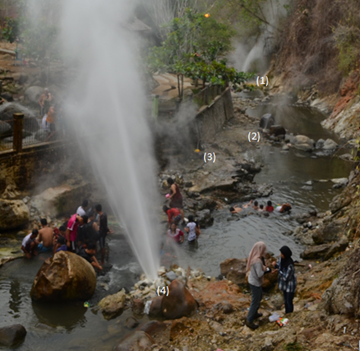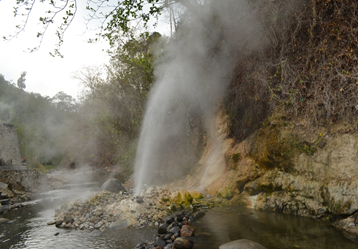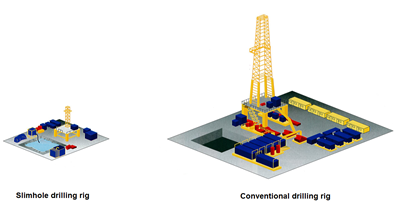INTRODUCTION
Resources for small scale geothermal power plants can come from hot springs with adequate flow rate, well head generating units of a high enthalpy wells, waste brine from a high enthalpy power plants, low-medium enthalpy wellbores in a volcanic hydrothermal systems and low-medium enthalpy wellbores in a sedimentary basin system. According to Vimmerstedt (1998), small geothermal projects are less than 5 MWe. Small scale geothermal power plants could use a flash system or binary cycle technology. Flash steam power plant in small scale applications are low cost, relatively simple, and require no secondary fluid. However, compared to a binary plant, the flash steam plant operates at higher temperatures. Binary plants operate at lower temperatures and use a second working fluid. Binary geothermal power plants use working fluids or chemical fluids known as a secondary fluid that boils at a lower temperature than water. To encourage geothermal electricity production, small scale also can contribute. This technique can be applied to more remote areas which are currently powered by diesel generators or become an alternative for low-medium enthalpy geothermal resources.
GEOCAP ACTIVITY IN THIS TOPIC
Within the GeoCap programme the potential for small scale geothermal power plants was studied in more detail, especially with the binary system. Technical, financial and social aspects have been studied. Main results of the technical aspect study are the power input and output scheme based on fluid properties and availability. The financial aspect study gives insight in the sensitivity on project cost versus IRR value as a function of parameters that been used. The social aspect study describes key factors to elevate the project. All aspect results will be used for arranging related stakeholder functions and the project time schedule.
Resources
Three types of low-medium enthalpy resources have been studied: surface manifestations, waste heat from geothermal power plants and sedimentary basins. After reviewing geothermal resources especially in West Java region, case studies have been carried out for three preferable resources.
Surface manifestations like hot springs
One potential manifestation for small scale geothermal power plants is located in the Cisolok area in West Java. The geothermal manifestation appears at 106°27’13.4” E and 6°56’0.5” S in the Cisolok River. Currently, the geothermal manifestation of Cisolok is used as a public bathing place. The thermal water discharging into the Cisolok River has high temperatures near boiling temperature, with neutral pH and relatively high discharge rate. Based on data from the survey, the manifestation has a temperature of 95°C and a mass flow rate of 5 kg/s.


Figure 64 Cisolok Hot Spring
Waste heat from geothermal power plants
Geothermal power plants do not use all heat for electricity production. There is still (waste) heat in the brine and condensate. The existing power plants in Western Java have available temperature levels between 45 to 175°C at a thermal power of 20 to 185 MW. Waste heat of the Awibengkok-Salak geothermal power plant has good potential, which is categorized as a two phase geothermal systems.
Sedimentary basins
Small scale grids in remote areas are numerous. At the moment, in many cases power is supplied using diesel generators. These are polluting and expensive. Sedimentary basins nearby existing small scale power grids could be used as an alternative source. Using slim holes, small scale geothermal wells can be realized, matching power demand and minimizing investment costs. Slim holes require much smaller drilling rigs, compared to conventional geothermal wells. Besides electricity production, many secondary outputs are possible, depending on the local needs. Possible secondary outputs are e.g. ice production, drinking water production, food processing modules, waste water treatment, and more.

Figure 65 Comparison between the size of a slimhole drilling rig and a convention one (source: Schlumberger)
Assessment Result
The net power that can be generated by the Cisolok hot spring is 23 kWe using n-pentane. The selection of the turbine pressure design that is used in this system is 3 bar. The mass flow of the working fluid is 1.2 kg/s. The power generation in Salak is generated by utilizing the brine after the separator. By simulating the binary cycle output, the total power that can be extracted is approximately 13 MWe. However, by referring to the small-scale project that we discussed, the maximum power generation for this case is adjusted to 5 MWe. Using n-pentane as secondary fluids with mass flow rate 89 kg/s will generate 5042 kWe net power. For the slim holes in sedimentary basins, electricity can be used using standardised low temperature ORC modules. Depending on the potential of the sedimentary basin, the power output is estimated at 300 – 1,500 kWe.


Figure 66 Process flow diagram of Cisolok (left) Salak (right) binary cycle
Required investment for a small scale geothermal power plant at Cisolok is estimated at 1.7 Million USD. This cost includes turbine, generator, heat exchanger, pre-heater, condenser, pumps, piping system, construction and pentane liquid. An electricity price of 102 USD cent/kWh will yield an IRR of 9.7%. For the Awibengkok-Salak case, investments are estimated at 16.6 Million USD. An electricity price of 23.8 USD cent/kWh will yield an IRR of 9.7%. The investments for a slim hole is estimated in the range of 5 M$ and 10 M$. Estimated levelized cost of energy are 0.10 – 0.20 $/kWhe. That is less than half that of pv-battery systems and a third the cost of power made from diesel generators.
Market and social aspects could contribute to the feasibility of the project. Although power generation is limited, a small scale geothermal power plant at Cisolok and Awibengkok-Salak will replace fossil fuel utilization for the Jawa-Bali Interconnection. Fuel demand and greenhouse effects could also decrease from energy diversification. Social mapping and social engineering programmes should be applied on Cisolok (in-situ) conditions to minimize potential social barriers in a small scale geothermal development and find effective solutions to mutual benefit, enabling successful small scale geothermal development. The estimated time to implement a small scale power plant is 5 years, which consist of a pre-feasibility study, feasibility study, business case, development stage, and commissioning. A project organizational chart has been defined. These tools can be used to eliminate barriers and implement effective management in the project development process.
Future outlook
Currently, geothermal small scale power plant using manifestations and waste heat are less attractive compared to large scale geothermal power plants. At remote areas, small scale geothermal power plants could be attractive, due to high costs for diesel generated electricity. In the long run, we anticipate increased costs of CO2 emissions and scarcity of fossil fuels. To be able to utilize small scale geothermal power plants, it is advisable to create a regulatory framework that fits with this market and technology. Also, to demonstrate the technology/market, it seems appropriate to start demo projects that would convince investors to apply the technology in the future.
Materials
CONTACT
- Nurita Putri H (ITB)
- Suryantini (ITB)
- Rob Kleinlugtenbelt (IF Technology)

